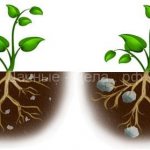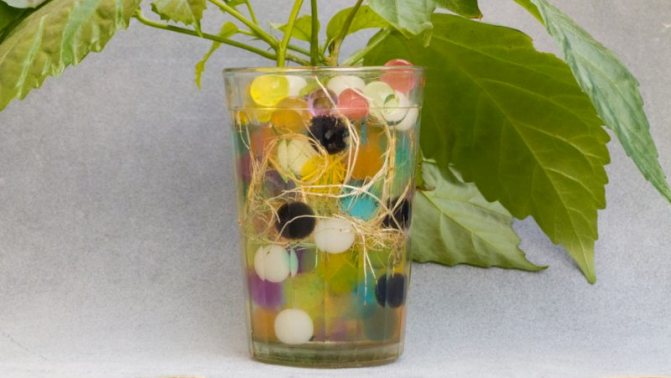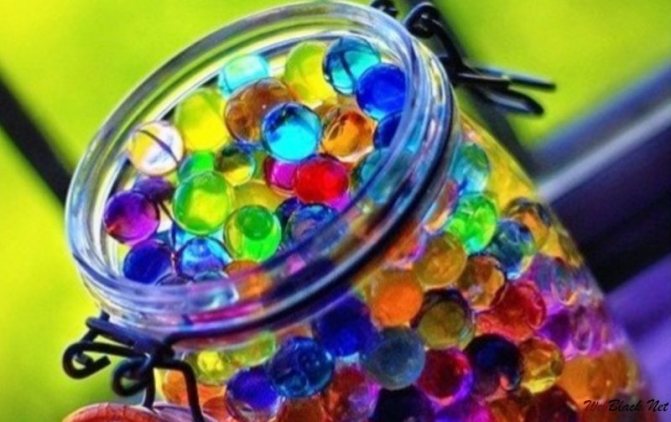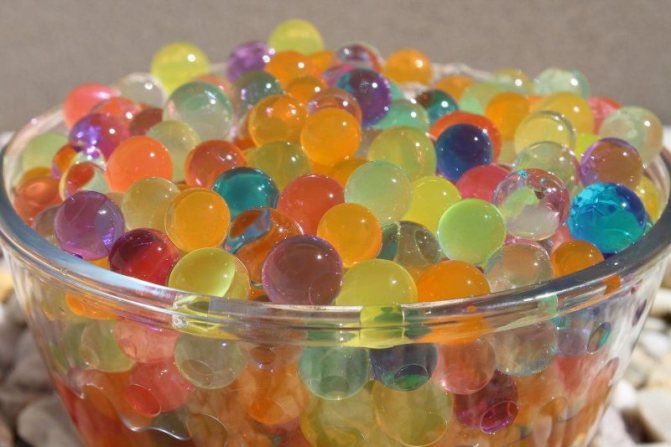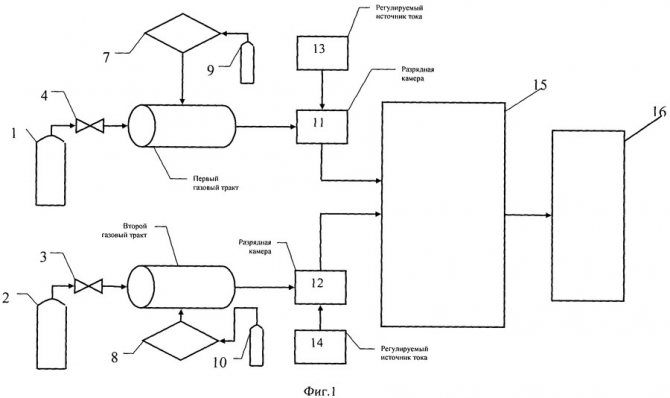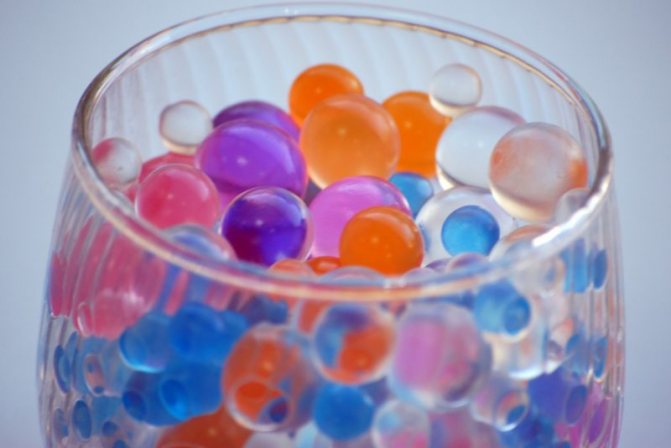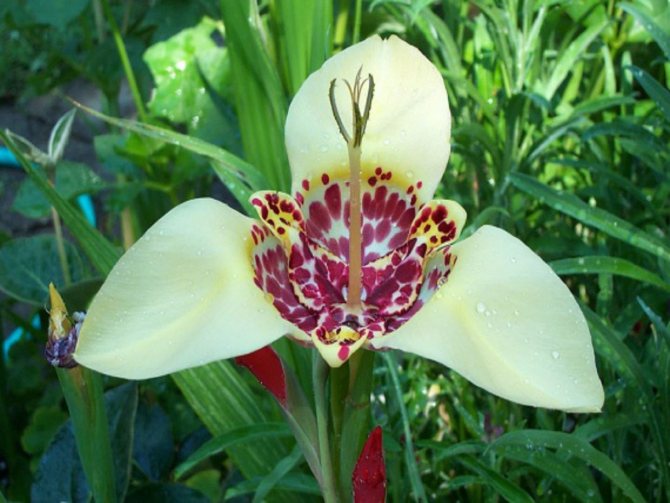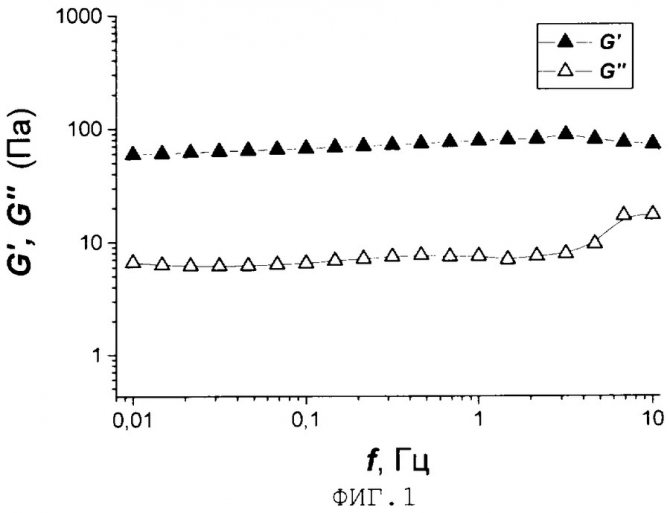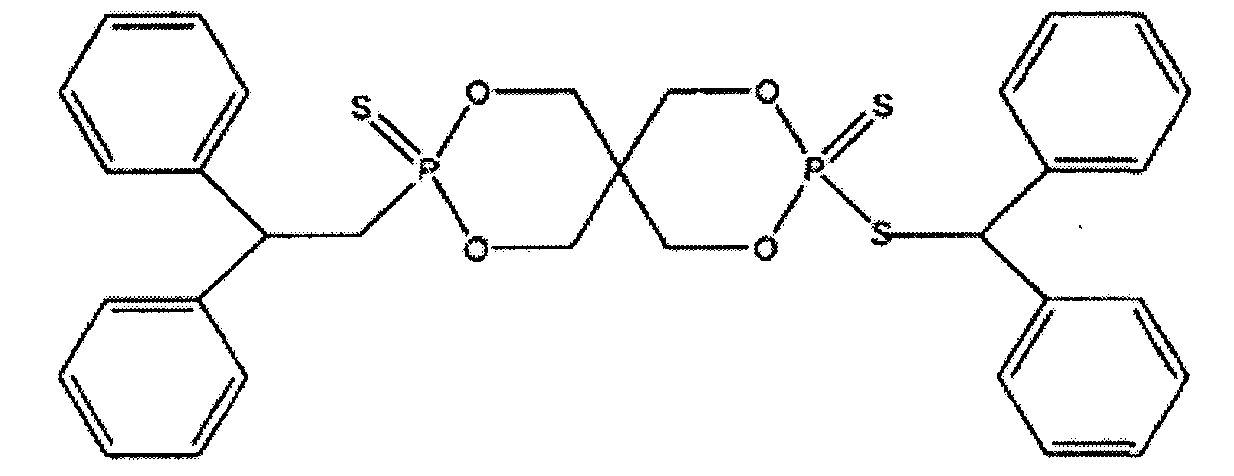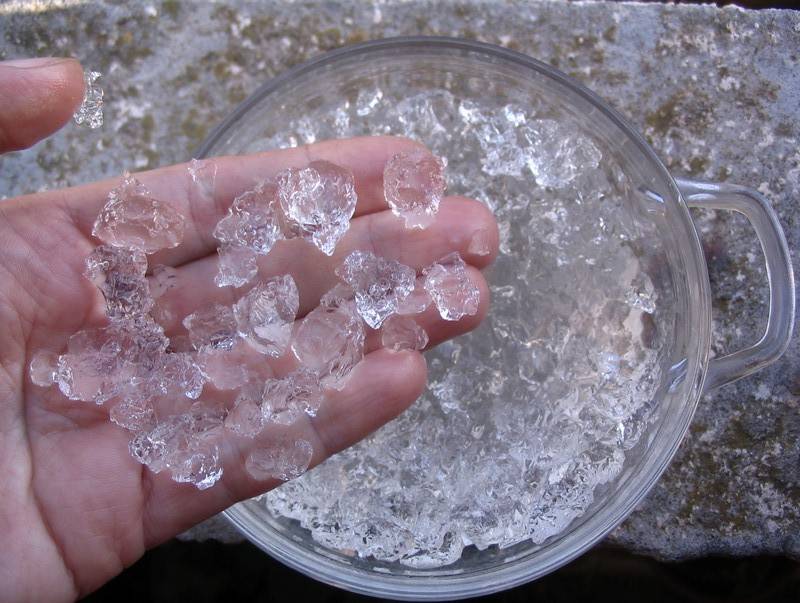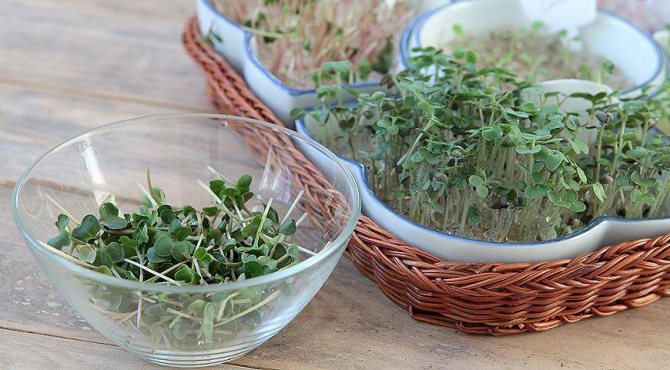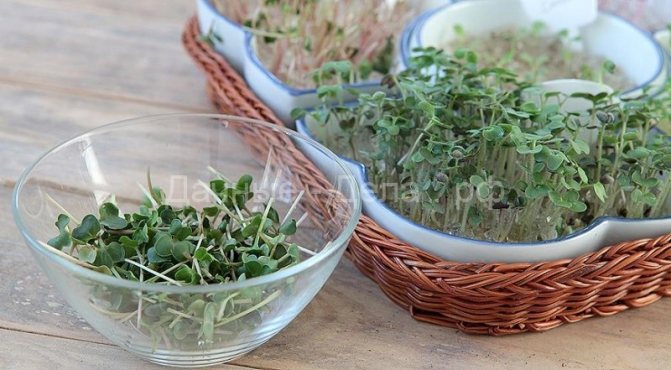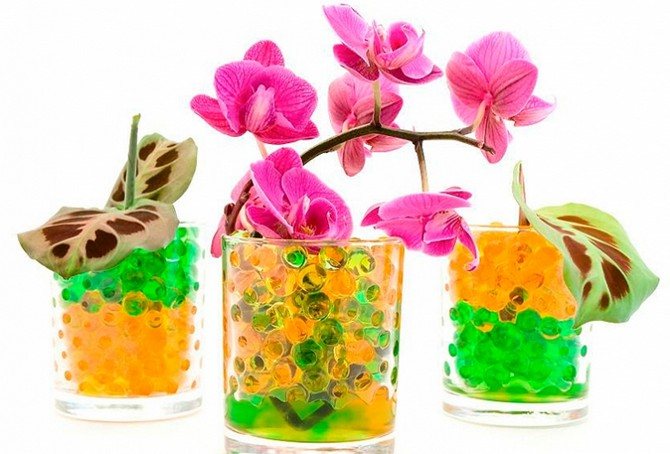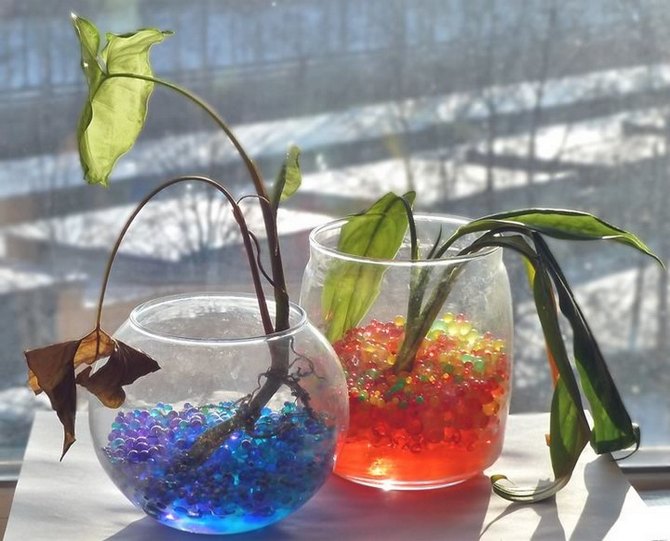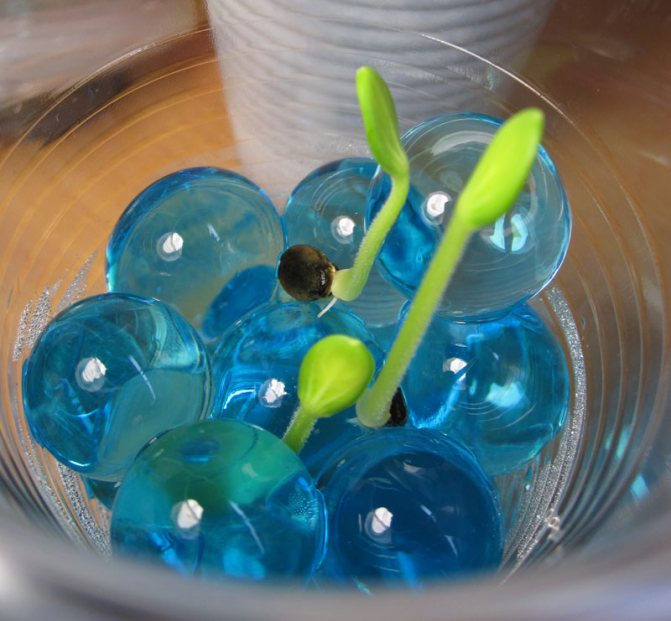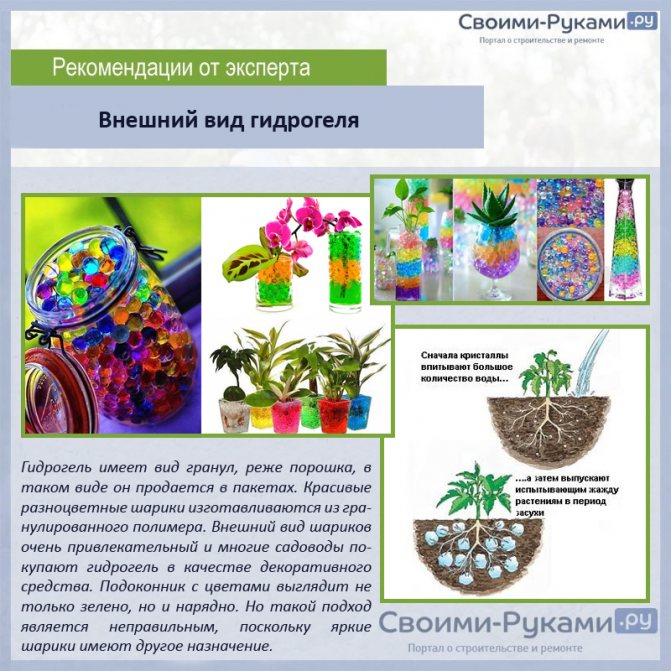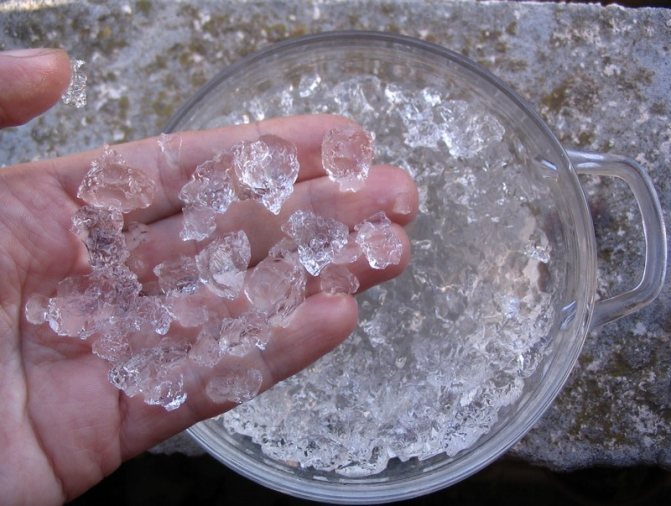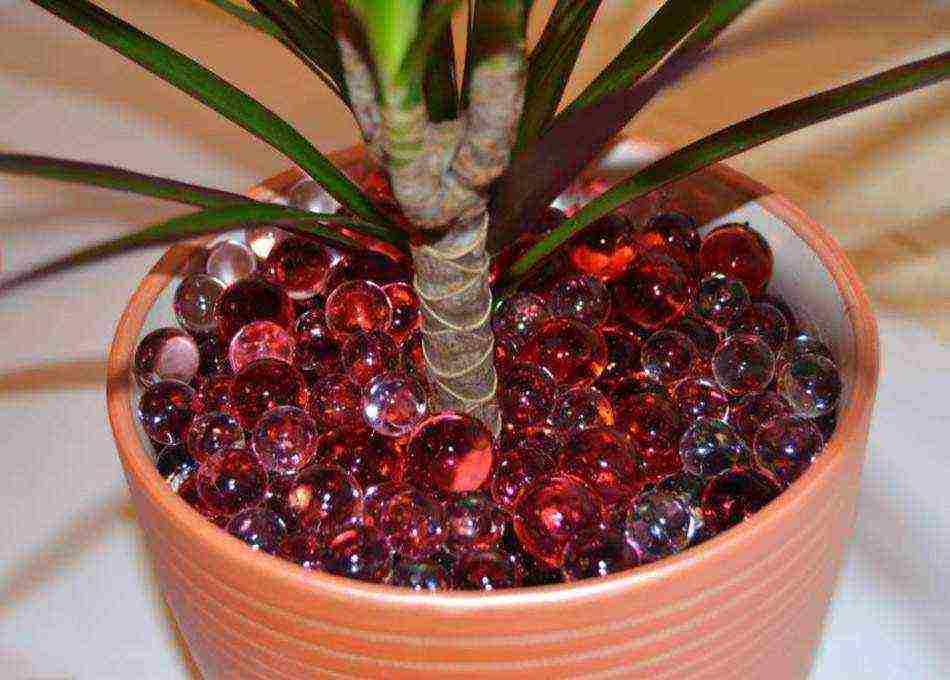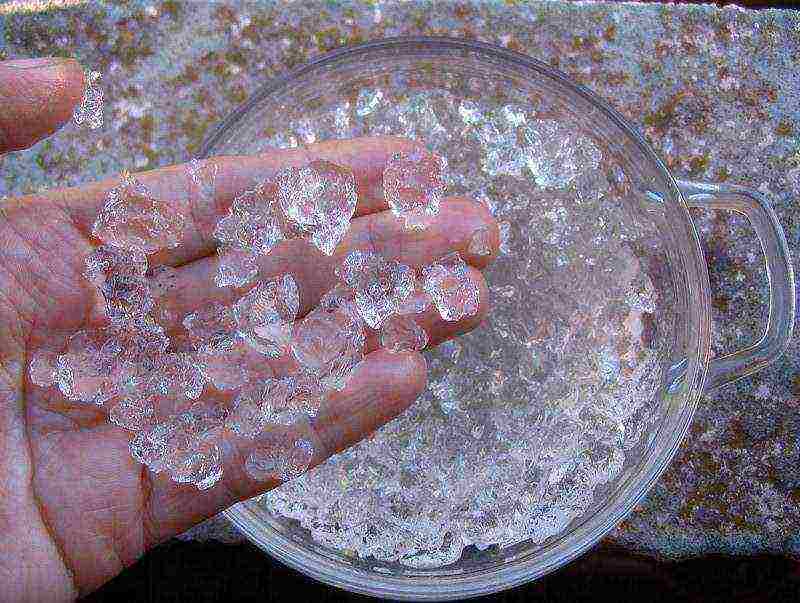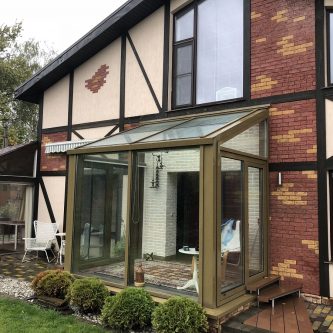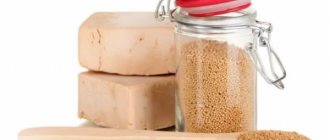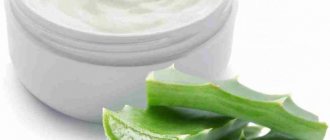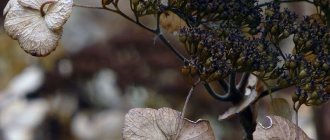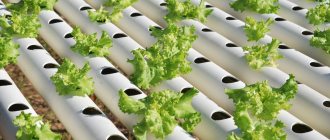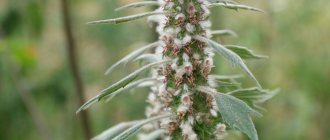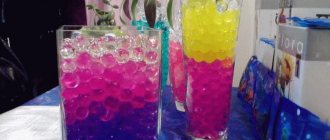In the summer, our flowers suffer from the searing heat. Especially it goes to those who grow on balconies - in hanging boxes, pots, baskets. The soil in containers dries up in a matter of hours, the root system is damaged. Container flowers at our dachas, where we come once a week, find themselves in an even more difficult situation. And you can't envy the plants growing in the open field either ... If there is no rain, then watering once a week will not solve the problem. The plantings will turn yellow, wither and gradually die.
But there is a solution that allows you to reduce the watering regime by 4-6 times! And the name of this miracle of the agricultural industry is hydrogel. It is a colorless powder or crystals that, when soaked in water, are saturated with it and turn into a kind of water reservoir. When added to the soil, the swollen hydrogel becomes a source of moisture for plants. Even when the soil dries up, the reserve "reservoirs" of the hydrogel remain full and the root system "pumps out" as much liquid from them as it needs. Well, isn't it a miracle?
What is the hydrogel for?
Many flower lovers will be interested in learning in more detail what a hydrogel is, how to use it so as not to harm your favorite plants. Recently, the tool is often advertised and in great demand. This is not surprising, because the colorful granules look attractive, and they can be used for different purposes
.
The hydrogel is in the form of granules, less often of a powder, in this form it is sold in bags. Beautiful multi-colored balls are made of granular polymer. The appearance of the balls is very attractive and many gardeners buy hydrogel as a decorative tool. A window sill with flowers looks not only green, but also elegant. But this approach is wrong, since the bright balls have a different purpose.
A hydrogel for indoor plants, good moisture absorption
... By sucking in water, the granules increase tenfold. One gram of hydrogel is capable of absorbing up to 200 grams of liquid. The gel balls give the accumulated moisture to the roots of indoor plants.
The flower hydrogel was designed to keep plants hydrated in between infrequent waterings. The swollen granules mix with the soil in which the flowers grow. On average, plants have enough moisture for 2-3 weeks. The roots grow into granules and absorb water. Much depends on the root system of flowers and its development. The granules continue to remain in the soil and after the next watering they are again saturated with moisture.
Due to this property of the hydrogel, plant roots will not rot from excess moisture. If you water indoor flowers with impure water, and with fertilizers, then the granules will be filled with this composition and bring double benefits to the plants. There are two types of hydrogels
intended for flowers.
- Soft - it practically has no color, due to its softness, the roots of plants freely penetrate through it and feed on moisture. It is great for those who cannot water the flowers often, and for germinating seeds and rooting cuttings.
- Dense (aqua soil) - can have different shapes in the form of balls, cubes, pyramids.It belongs to decorative types of polymer, used for germinating seeds, It is convenient to use instead of water in vases with bouquets of flowers.
What is a plant hydrogel and how does it work?
According to the chemical formula, hydrogel refers to polymers (cross-linked copolymers) capable of retaining large amounts of water and fertilizer solutions. The absorbency of the hydrogel is such that 1 g of dry matter can absorb 0.2-0.3 liters of water.
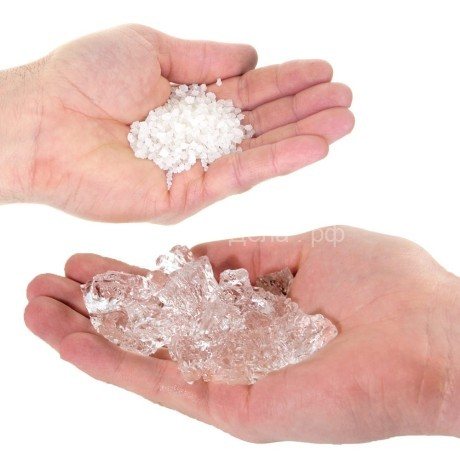
Dry hydrogel and saturated with water - 200-300 times magnification!
For the hydrogel to start working, it must be introduced into the soil in the access zone of the plant root system. Most often - in an already swollen state, saturated with water, less often - in a dry state (then abundant watering is required immediately after application).
After 2-3 weeks, the roots of the plant will grow through the hydrogel capsules and will be able to absorb moisture from there without waiting for the next watering. The soil between waterings may dry out completely, but this will no longer be a shock to the root system. The hydrogel will serve as a back-up water source to keep the plant from withering and drying out during dry periods.
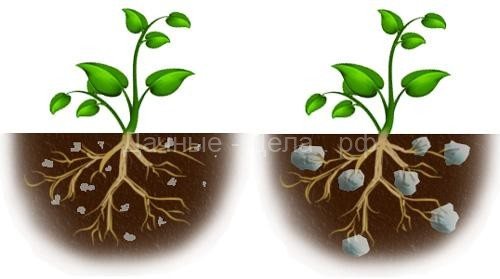

The roots of the plant grow into the hydrogel and begin to feed on water from there.
Hydrogel granules can be saturated not only with water, but also with fertilizer solutions. Then, in your absence, the flowers will not only not fade, but will continue to eat "right".
Due to the ability to adsorb moisture, the hydrogel has another property: it will not allow the flowers to flood. Any excess moisture that would normally drain through the drainage holes is absorbed into the hydrogel and then absorbed by the plant as needed.
I would like to note right away that this article is not about the Chinese hydrogel or, as it is also called, "aqua soil". These are slightly different materials, although they have a similar polymer nature. The purpose of the agrarian hydrogel is to serve as a source of additional water for plants. The main purpose of the aqua soil is a decorative effect.
Hydrogel: instructions for use
Hydrogel granules come in a variety of colors and sizes, and are sold as such. Packaging may vary in weight
... Typically, small granules are used to germinate seeds, while larger granules are used to add to the soil. The color of the substance does not affect its properties.
Before using the gel, it is soaked in water, after which it absorbs moisture and significantly increases in size. It is believed that only 2 tablespoons of granules are enough for a 3-liter volume. After the granules are filled with water, they can be thrown into a colander and the remaining water drained.
Unused pellets can be stored perfectly in the refrigerator in an airtight container. If stored at room temperature, they shrink and crystallize.
In order to germinate seeds, the hydrogel balls must also be saturated with water and preferably with fertilizers. In this state, it will do more good. The pellets themselves do not contain the nutrients necessary for the plants, so water-soluble fertilizers will promote good growth and seed germ development
.
Very often, gardeners use the substance to germinate seeds in several convenient ways. Much depends on the size of the seeds. Initially, the hydrogel was invented for use in agriculture, but as time has shown, it has become more in demand among flower growers.
The seeds can be sown in pure gel with water. After being saturated with moisture, they swell greatly, after which they can be crushed to the desired state in a convenient way:
- rub through a sieve;
- grind with a blender.
The prepared mass is laid out in a container with a layer of 3 cm and seeds are spread on top. Very large granules can be cut in half and spread the seeds on top by gently pressing with a toothpick.If the seeds are buried too deep, they will not have access to air. The entire seed is covered with foil. It needs to be removed periodically to ventilate the seeds.
Very often, gardeners use hydrogel to grow seedlings, in the ratio 3-4 parts potting mix and 1 part granules
... The prepared mixture is filled in containers for growing seedlings and a thin layer of pure crushed hydrogel is placed on top. Seeds are placed in the top layer of the gel, after which they are sprayed with water and covered with a film.
You can germinate seeds in a pure gel, but in the cotyledonous leaf phase, the seedlings must be transplanted into the ground. It is advisable to transplant with a piece of gel so as not to damage the root.
Plant hydrogel application
The tool is often used to grow indoor flowers and plants in the garden. It is usually added when planting in a hole or in a potting soil. Due to its ability to retain moisture, the hydrogel is very convenient to use for those who do not have the opportunity to frequently water the plants.
The gel is very convenient to use, it can be apply dry and soaked
... The dry matter after watering will immediately absorb excess moisture and then give it to the plants. Experts recommend using a swollen gel for potted plants, and adding it dry in the garden. The proportion will depend on many factors:
- soil condition;
- planting conditions;
- frequency of watering.
For a long time, the hydrogel will absorb moisture and then give it to the plants. After the expiration date, it decomposes into ammonium, water and carbon dioxide
, and nothing else is in it.
Hydrogel and aqua primer - what's the difference?
At the peak of its popularity, many unscrupulous manufacturers of this product began to produce a completely different product. It has nothing to do with the hydrogel. A colorful alternative called "aqua primer" has an attractive appearance and is in high demand. The tool is available in different forms, which performs only a decorative function
... If used incorrectly as part of a potting mix, it will only harm the root flower system.
The sensational advertising also often misrepresents information, for example, that aqua soil can be used in its pure form for germinating seeds. Buyers confuse it with a hydrogel and only harm their flowers and seeds. For this reason, a lot of negative reviews about the hydrogel began to appear. Many people simply confuse it with aqua soil, use it incorrectly, so the end result is disastrous.
When buying an aqua primer or hydrogel, you need to consider for which types of plants the products will be used. They are suitable for some plants, but there are types, showing negative reactions
... It is best to use both products in a potting mix to keep the flowers in their familiar environment. Hydrogel or aqua soil in its pure form does not have nutrients, therefore it cannot create the necessary conditions for the active development and growth of flowers.
The hydrogel, sold in the form of crystals of various sizes, which can swell very strongly in water and then retain moisture for a long time, gradually giving it to plant roots, is a reliable assistant for flower growers, gardeners and gardeners. (in the house, on the balcony, in the open field) need watering much less often, develop better and suffer less from heat.
Of course, plant lovers are only interested in high-quality and specialized hydrogel - designed specifically for agriculture, i.e. for environmentally safe and successful plant cultivation in indoor floriculture and home gardens.All these requirements are fulfilled by a modern hydrogel, produced taking into account the latest achievements of science and complying with strict standards, which has passed certification. Such a high-quality, harmless hydrogel is used by plant lovers in many countries of the world and guarantees excellent long-term results when used correctly according to the attached instructions.
Many florists and gardeners spend in the home and garden using a hydrogel.
In what areas is it possible to use hydrogels?
Diapers
Hydrogel dressings aren't the only uses for hydrogels. Considering the fact that many health problems are associated with the massive use of disposable diapers, hydrogel bandages in a diaper base can be a great alternative.
More than 95% of diapers in all countries are disposable, and opinions on cloth diapers are still controversial. It is known that many of the chemicals used in the manufacture of diapers, such as fragrances, seals and superabsorbent polymers, contribute to the development of several diseases, from asthma to male infertility or even testicular cancer.
An interesting application of the hydrogel is in the production of superabsorbent diapers that have drying properties even after significant absorption of liquid.
This material does not act like a sponge, trapping liquid unstably in its pores, instead it retains water and other solvents while using only significant amounts of water at the same time.
The development of hydrogel diapers over the past two decades has reduced a huge number of dermatological conditions associated with prolonged skin-to-wet tissue contact (source).
Perfumery
In recent years, numerous patents have appeared describing technologies for the delivery of volatile compounds. The most significant patented inventions in this area are held by Procter & Gamble. It was they who first began to process flavors in cyclodextrin complexes.
Devices are now being developed that can slowly release fragrances into the environment. Hydrogels again play a special role in this process, namely their swelling properties, due to which the release of the perfume smell is accompanied by the dynamic swelling force of the polymer when it is wetted.
Cosmetology
The cosmetics industry is a market that is constantly expanding in the range of products it offers.
The most important parameter for approving the use of substances in cosmetic products is the Primary Irritation Index, which is the same for both the eyes and the skin.
Given that most of the hydrogels used in this field are suitable for cell culture and other biomedical applications, it is not surprising that their irritation index is one of the lowest.
That is why, with relatively small investments, companies are now launching new cosmetic products based on hydrogels on the market. These are hydrogel masks - the same hydrogel bandages, only in their shape they flawlessly cover the entire face.
They are usually made using collagen, hyaluronic acid, or polyvinylpyrrolidone. These masks quickly moisturize the skin, restore its elasticity and counteract aging.
It is especially useful to use them after aggressive cosmetic procedures, such as chemical peels, laser resurfacing, dermabrasion and others. Hydrogel dressings perfectly soften and dissolve the crust that forms on the skin after these procedures.
Irrigation granules for plants
Another simple application for hydrogels is polyacrylamide powders used as a long-term water reservoir for plant growth. These materials optimize the ability to release water instead of retaining it.
Plastic surgery
Hydrogel is considered a good material for use in direct contact with the human body due to its extracellular matrix-like properties.
An example is hyaluronic acid. For many years, it has been considered a panacea for tissue filling.
The development of new biocompatible hydrogels will even make it possible to replace silicone prostheses to increase breast size and shape.
Water purification
Due to the similarity of hydrogels to water, they can be used in two different ways to purify water.
1) They are suitable as a carrier of microorganisms by encapsulating them inside various carrier materials. Chlorella and Spirulina are the most commonly used algae.
These microorganisms have long been used to remove contaminants from water. The idea is to keep bacteria inside the hydrogel mesh, which will therefore protect against harmful bacteria and purify the water.
2) Modification of hydrogels, which will allow them to capture and retain pollutants within the networks. Thus, it is even possible to capture heavy metal ions.
Hydrogels as soft contact lenses
The main reason for the development of hydrogels is contact lenses, because they not only correct vision, they also have other functions. The most commonly used polymer used in the production of soft contact lenses is hydrogel silicone, which has excellent oxygen permeability.
These lenses can be used to treat eye infections. Only about 5% of drugs administered with eye drops are bioavailable, with eye drops currently accounting for over 90% of all ophthalmic drugs.
The bioavailability of ophthalmic drugs can be improved by ophthalmic drug delivery using soft contact lenses. For this, several polymer hydrogels for conventional contact lenses with absorption and release of ophthalmic drugs have already been investigated.
Over the past decades, significant progress has been made in the field of hydrogels as functional biomaterials. Hydrogel dressings are of particular interest because they have made it possible to treat dangerous wounds, including burns, at home and not in a hospital.
Although hydrogel dressings are not a problem to buy now, their potential has not yet been fully explored. These materials have proven their worth in contact lenses, hygiene products, wound healing agents, and even in tissue engineering.
Not all plant species benefit from hydrogel
It should be emphasized that from a large assortment of indoor plants, only moisture-loving species and herbaceous plants with soft leaves that do not tolerate prolonged drying out need to add hydrogel to the soil. They consume and evaporate large amounts of water, requiring frequent watering. When handling such plants, the hydrogel added to the substrate has shown excellent results. Houseplants planted with hydrogel were much less likely to need watering, which is especially important when they are found in a hot summer on a glazed loggia.
Unlike moisture lovers, drought-resistant plants (epiphytes) with thorns and dense leaves do not need regular maintenance of the substrate moisture - on the contrary, their roots easily rot because of this. Therefore, when sowing and planting such plants, it is not necessary to add hydrogel to their light, permeable substrate.
Practice has shown that when germinating seeds and growing seedlings, the addition of hydrogel to the substrate turned out to be useful not for all types of herbaceous plants used for and gardening.
When sowing plant species with very small seeds (, etc.) and plant species suffering from even the slightest waterlogging of the soil (, etc.), the addition of hydrogel to the substrate greatly inhibits the development of seedlings.At the same time, small seedlings grow slowly and look depressed. Their thin, delicate roots are especially vulnerable to a lack of air in a moist substrate, which dries very slowly with a hydrogel. Therefore, in a humid environment created with the help of a hydrogel, small plants become even more vulnerable; they have a high risk of occurrence.
There is no need to add the hydrogel to the substrate during the first pick of small seedlings, which have not yet developed a root system - it does not yet need and even harmful the huge amount of moisture that the surrounding roots of the hydrogel accumulates.
But when grown seedlings with a well-developed root system are planted in individual pots (or planted in pots, planted in a permanent place in open ground), then in these cases the addition of hydrogel to the substrate for filling containers or to the planting holes of flower beds and beds becomes very even desirable! Numerous, actively growing roots are already ready to consume the amount of moisture that the swollen hydrogel crystals constantly provide them.
When planting grown seedlings of ornamental plants in pots and garden flowerpots (drainage holes in them are required), it must be remembered that at first the watering of the seedlings should be very moderate until they completely take root there. That is why containers with planted seedlings must first be kept under a roof so that young plants are not flooded in rainy weather. The same "golden rule" applies here as with: waterlogging of the substrate in pots with plants, the roots of which have not yet fully mastered the entire space of the pot, is fraught with acidification of the soil. As a result, algae appear in the pot and, and the roots of the plants suffer from lack of air.
Therefore, when adding a hydrogel to the substrate, which retains a lot of moisture, you need to be especially careful when watering container plants. Especially in cases where only 1-3 seedlings are planted in a large flowerpot. For example, this applies to ampelous petunias, when we plant only in the spring (see title photo). Already at the beginning of summer, such petunia grows strongly and blooms magnificently, and soon forms a powerful cascade of shoots with an abundance of flowers.
Adding hydrogel to the substrate is desirable when sowing garden seedlings, the roots of which feel very comfortable in a constantly humid environment. The same applies to herbaceous plants with numerous and large leaves grown from large seeds (etc.), which grow well and fully bloom only with sufficient moisture. Their strong root system develops very actively and is able to quickly master the surrounding space, strong roots absorb a large amount of water from the substrate. In these cases, the hydrogel added to the substrate has a very beneficial effect on the development of seedlings at any stage of their development.
What are hydrogel dressings?
They were developed to regulate the exchange of fluid on the wound surface. The hydrogel compounds that aid in the healing of the layers of skin, veins, and tissues are replaced by sodium and other wound secretions.
Although hydrogels are made from various compounds, they usually consist of approximately 90 to 99% water, which is suspended in the gel base, while providing the appropriate amount of moisture for speedy wound healing.
Some hydrogel dressings have a cooling effect to relieve any pain. Due to their gel form, the dressings can additionally be used to simulate a flat tissue surface, fill “dead space” or deeper areas of wounds that would otherwise be very difficult to heal.
Such gels contain liquids 500 times their size in terms of their molecular capacity. In addition to the continuous moisturizing and cooling effect, they serve as a kind of barrier to protect the wound from inflammation and bacterial growth.
The hydrogel is also used in tissue engineering, hydrogel implants, contact lenses, and hygiene products.
Potential applications of all types of hydrogels also include synthetic extracellular matrix, implantable devices, biosensors, materials that control enzyme activity, etc.
Features of the use of hydrogel for potted plants
If you add a dry hydrogel to the pot, which is required in a scanty amount (and fractions of a gram and a gram are very difficult to accurately measure and evenly distribute), then after watering the planted plant, there is a high risk of swelling of the soil in the container due to the highly swollen hydrogel. In this case, the hydrogel can strongly shift or even displace the seedlings from the pot!
Therefore, when planting seedlings in containers, I use only swollen hydrogel
by pre-soaking dry crystals in water according to the instructions. I carefully mix the substrate with the swollen hydrogel in the recommended proportions so that it is evenly distributed in the volume of the pot and is available for the entire root system of the planted plants.
In a pot with drainage holes, at the bottom of which a drain is placed, I pour the bottom layer from a mixture of a substrate with a swollen hydrogel. The thickness of this lower layer is calculated depending on the height of the root ball of the seedlings and the thickness of the upper layer. I place the right amount of seedlings in the pot. Sprinkle the root ball of seedlings from all sides with the same mixture of substrate and hydrogel, slightly compact, water. Then I add the mixture of the substrate with the hydrogel almost to the level of the root collar. Further, some kind of mulch is usually poured into the pot from above, up to the root collar of plants. In this case, the uppermost mulch layer (mulch or substrate, if mulch is not applied) should no longer contain hydrogel. Indeed, in the light, the hydrogel dries quickly and collapses, ceasing to perform its functions.
How are hydrogels different?
Hydrogels can be divided into two different categories: natural and synthetic. Natural hydrogels include collagen, fibrin, dextran, hyaluronic acid, matrigel, and derivatives of natural materials such as chitosan, alginate, and other fibers.
They remain the most physiological hydrogels, since they are components of the extracellular matrix. However, two major disadvantages of natural hydrogels are that their final microstructure and properties are difficult to control.
First, their mechanical properties and dependence on polymerization or gelation conditions are often poorly understood by manufacturers. Secondly, due to their natural origin (bovine fibrinogen, rat tail collagen), their composition can vary significantly from one batch to another.
Synthetic hydrogels such as poly diacrylate, poly acrylamide, polyvinyl alcohol are more reproducible, although their final structure also depends on the polymerization conditions, so strict ambient temperature control is required.
In general, synthetic hydrogels provide great flexibility in adjusting chemical composition and mechanical properties. Hydrogel manufacturers can change the concentration or molecular weight of the starting materials, change the percentage of crosslinking agents.
Hydrogels can be chemically stable, or they can degrade, eventually disintegrate and dissolve. They are called "reversible" or "physical" gels, when networks are held together by molecular beams or secondary forces.
When a polyelectrolyte combines with a polyvalent ion of opposite charge, a physical hydrogel is formed, known as an ionotropic hydrogel, such as calcium alginate.
Hydrogels are called "permanent" or "chemical" if they resemble covalent networks without crosslinking.
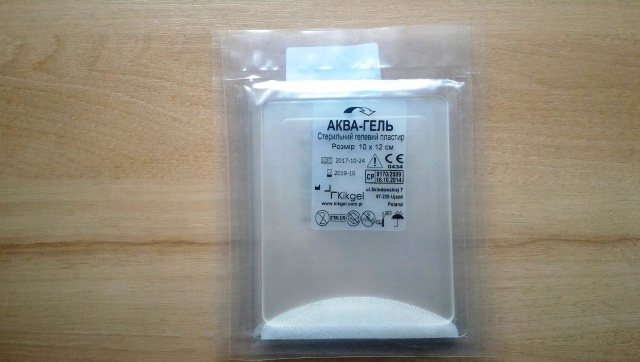

Features of the use of hydrogel for seedlings in the open field
When planting seedlings of flowers and vegetables in open ground, it is also advisable to prepare a mixture of the substrate with a swollen hydrogel in advance to fill the root system of the seedlings. This is the best option for ensuring uniform moisture saturation of the roots of the seedlings, as well as economical use of the hydrogel. However, with a very large number of planted seedlings and with a lack of time, this option is not always possible.
Another suitable option for the introduction of hydrogel when planting seedlings is in a swollen form, which is added directly to the planting hole. Pour the hydrogel crystals into a bucket of water. After they have swollen, using a light plastic spoon with a long handle (from the kitchen set, it does not sink in a bucket of hydrogel), I gradually add the swollen hydrogel to the bottom of the hole, and on the sides - in the lower part of the root ball of the seedling installed in the hole. Then I cover the hole with garden soil and mulch the surface of the earth around the seedling.
The third option for the introduction of a hydrogel when planting seedlings is the addition of dry crystals to the planting hole. This option is the fastest, since it does not require any preparatory work, but it turned out to be less preferable.
First, dry application consumes much more hydrogel than the plants require. Indeed, in the field, it is unrealistic to measure grams and fractions of a gram of dry hydrogel. Therefore, when planting seedlings, crystals are introduced "by eye". In this case, undesirable consequences in the form of swelling of the soil are possible due to too much hydrogel volume after swelling of the crystals.
Secondly, if you add a dry hydrogel to the bottom of a shallow pit, then when it swells, it can significantly shift and even displace the planted plant from the pit, as was already described above for seedlings in pots. Therefore, I do not apply the dry hydrogel directly to the bottom of the hole, but only lightly sprinkle it on the sides of the lower part of the root ball of the seedling placed in the hole, and then fill the hole with garden soil and slightly compact it. But even in this case, for small pits, there is a very high risk of swelling of the soil around the planted plants after the hydrogel swells. If this happens, it is necessary to immediately remove (above the soil surface and slightly below) the hydrogel that has crawled out after swelling and use it elsewhere, and add the required amount of soil to the plant and mulch.
Pros and cons of hydrogel
However, the new material among vegetable growers has not yet gained mass distribution. This is primarily due to its recent appearance on our market and ignorance of its main advantages. So that the grower does not wonder whether it is worth using a hydrogel for growing seedlings, we will consider all its advantages and disadvantages.
The use of polymer granules for the gardener gives the following positive points:
- The amount of water absorbed by the hydrogel is 300 times its own weight, which allows maintaining the necessary soil moisture for a long time.
- Possibility to save space.
- Seed growth begins much earlier than with traditional cultivation.
- The seeds and root system of the seedlings are aerated.
- All microelements in the substrate prepared for planting are not washed out and completely preserved.
- Throughout the entire growing cycle, the plant is in favorable conditions.
- Cost effective material. For one liter of base, 0.8 ... 1.6 g of dry material will be enough.
With the obvious advantages available, the disadvantages of using a hydrogel are:
- The inability to grow crops with leathery seed shells (sweet peas, etc.). Also, when introducing seeds into a hydrogel, the individual characteristics of the plant should be taken into account.
- Maintain the required temperature of the surface on which the seedlings with hydrogel are located.This will help avoid hypothermia of the seedlings.
- Granules cannot be reused, although advertisers claim otherwise. Reviews of the hydrogel, in which the seedlings have already grown, are not too positive. First of all, its main absorbing qualities are lost, moreover, it shrinks and darkens. When the jelly-like granules interact with air, bacteria can settle in it. The maximum that such a material can be suitable for is using it as a water-retaining additive in the soil.
All the above pros and cons of the hydrogel will allow the grower to really assess their chances of getting good seedlings.
Planting and transplanting garden plants using a hydrogel
The use of a hydrogel when planting and transplanting garden plants allows them to transfer these procedures completely painlessly and quickly take root in a new place. Indeed, even when digging up a plant completely with a large clod of earth, part of the roots is inevitably damaged.
It is very useful to use a hydrogel in cases where a considerable time passes between digging and planting a plant. It is especially desirable, and sometimes even vital, to use a swollen hydrogel to protect the root system from drying out during long-term transportation and shipment of the excavated plant.
I would also like to draw the attention of gardeners to another important point concerning the life of some garden dwellers. Considering the regular use of hydrogel in greenhouses and flower beds, which we mulch with a large amount of mowed lawn grass throughout the garden season, I noticed that the structure of the soil and its nutritional value for plants significantly change for the better. As a result of the use of hydrogel and mulch, they multiply very actively in the garden soil (and they further increase its fertility). Under a layer of mulch, in loose moist soil, they love to hide from the heat (they spend the winter there), which in the evenings go hunting and destroy in the garden. Therefore, I try not to dig up the earth and do not pull out the tops in flower beds and greenhouses by the roots, so as not to harm the useful inhabitants of the garden hiding in the soil. In the fall, I cut off the tops at ground level, and in the spring, the remnants of almost rotted roots are easily removed from the light soil.
Elena Yurievna Ziborova (Samara)
On the site on the site on the site on the site on the site
Weekly Free Site Digest Site
Every week, for 10 years, for our 100,000 subscribers, an excellent selection of relevant materials about flowers and garden, as well as other useful information.
Subscribe and receive!
Everything in our life is progressing, everything is moving forward, technologies are improving. This did not bypass the niche of dacha farming. For example, the latest innovation is the hydrogel, which makes plant care easier.
This polymer material is not very popular with most gardeners, but in vain, because it has an undeniable number of advantages.
Without moisture, plants die, even the most drought-resistant specimens. Even short-term precipitation cannot provide sufficient soil moisture to a depth of 25-30 cm. Thus, watering trees, shrubs and flowers is one of the main components of plant care.


Hydrogel and aqua primer - what is the difference
It's time to figure it out and find the differences between aqua primer and hydrogel. Many people think that they are one and the same remedy. But experts say that this is far from the case.


Aqua primer is used only for decorative purposes. If you reduce watering at the same time, the plant will die.
What are the other differences between aqua soil and hydrogel:
- the product does not decompose;
- colored granules, sometimes with the addition of glitter and rhinestones;
- available in the form of stars, rhombuses, and other geometric shapes;
- has an attractive pricing policy;
- can only be used for decorative purposes.
Hydrogel - know-how in floriculture and horticulture. This tool makes it much easier for summer residents to care for plants. The number of waterings is reduced to several times a week. Flowers with an underdeveloped root system can do without watering at all for up to 2 - 3 weeks.
It is important not to confuse hydrogel with aqua primer. These tools perform completely different functions. The task of the aqua soil is to give an aesthetic appearance to a flowerpot with a plant. These balls have nothing to do with moistening.
About hydrogel
A hydrogel is a crystal, 10 g of which can absorb 25-30 liters of water.
After drying, the granules again turn into crystals and, when water gets in, again begin to acquire a gel-like appearance, giving moisture to the plants.
The granules also easily absorb excess moisture, preventing the root system from suffering from waterlogging.
Thus, we can talk about the beneficial properties of the hydrogel, such as the even distribution of water and the preservation of nutrients of fertilizers near the root system of plants, preventing it from being washed out in groundwater.
Moreover, the hydrogel improves the structure of the soil without reducing the effect for five years, provided that it is used annually with a decrease in dosage.
The use of a hydrogel becomes a "life jacket" for those summer residents who are forced to visit their sites on weekends or during your long absence. It is used not only in open ground conditions, but also in greenhouses, pots and even for indoor floriculture, reducing the amount of watering.
Using a hydrogel, summer residents will be able to significantly save on mineral fertilizers. No, this does not free you from the use of dressings, just a hydrogel absorbing fertilizer with water does not allow microelements to "go" into the groundwater, and due to rare watering, the consumption of fertilizers is reduced by about half.
How to use the hydrogel
Here it is necessary to clarify that the action of the hydrogel is point-like, i.e. it is laid out in each hole or bed before sowing crops. It works well for abutilon, mimosa, fuchsia, passionflower, nightshade, cucumbers, tomatoes and a number of other plants.
Pour 10 g of dry hydrogel into each hole before planting trees, then place a seedling, cover with soil, compact and water well so that the hydrogel absorbs water and gives the required amount of water to the root system.
Many summer residents buy tree seedlings in the fall and store them during the winter or in the basement.
- It is better to lower these planting specimens immediately before planting into the prepared hydrogel solution (10 g of dry hydrogel per 1 liter of water) so that all the roots are enveloped in polymer.
- Water can be replaced with a complex mineral fertilizer.
- For the best effect of swelling of crystals, the solution is left for 4-5 hours.
For indoor floriculture, hydrogel will also be a godsend. If the plant has already been planted and a transplant is not expected in the near future, then pour the gel-like polymer into the holes made with a pencil in the ground. When planting a new plant, 1-2 g of hydrogel is mixed with soil, a volume of which is placed in a liter jar.
Use the hydrogel only on plants that require frequent watering. Plants with dense leaves (epiphytes are plants from the bromeliad family) do not need frequent watering, so the hydrogel in this case will not play a plus. The water will stagnate, and fungal formations will begin to appear on the soil surface.
You can forget about watering indoor flowers for a month like this:
- Make 3 holes in the soil with a pencil to the depth of the root.
- Pour 1 g of dry hydrogel into each, pour over.
- Before leaving, make 3 more holes, another 3 g of hydrogel and one more watering.
- Cover the window with a newspaper or remove the flower pots from the windowsill.
- Everything, you can get ready for the road.
An excellent result is obtained by germinating seeds in a hydrogel, or for growing greens (lettuce and others) on a windowsill.Any soil dries quickly and the sprouts begin to lose their vitality, and water is retained in the hydrogel, preventing the roots from rotting.
When picking, the hydrogel is laid out on the bottom of the cups, and if the seedlings continue to grow in a wide container, then the hydrogel is laid out in a tray. For containerized hydrogel use, the crystals are always soaked. The planted plant can squeeze dry crystals out of the container.


To germinate seeds, dilute the hydrogel in water (10 g per 3 l), drain the excess water through a sieve. Spread the gel-like substance in containers, carefully spread the seeds at a distance of 5-7 cm and spray with water. The seeds cannot be buried in the gel, there is no air. Sprouted seeds are taken out with a tablespoon (with gel) and planted in the ground, after having poured dry hydrogel (1 g) or ready-made gel (200 ml) on the bottom.
It is extremely important to use a hydrogel when growing cucumbers. We all know the disappointment of the bitter taste of this vegetable, and so one of the reasons is the lack of moisture, which can be easily dealt with by expanding the finished hydrogel under the roots. If the cucumbers have already been planted, then the soaked hydrogel is mixed with the soil around the plant to the depth to which it will be possible, being careful not to damage the root system.
For radishes, beets and carrots: when planting, add 30 g of hydrogel per square meter, water well, then watering once a week will be enough. In the fall, dig up the garden bed, and in the spring again, when planting, add 30 g of hydrogel, see for yourself for further watering, it may not be needed at all. Next year, add 20 g of hydrogel per 1 sq. M.
For spot use of a hydrogel, 100 g is enough for 1 hundred square meters of land.
As we know, strawberries love a lot of moisture, which means when planting, dip the roots in the gel, and spread 50-100 ml of the diluted hydrogel on the bottom of the hole. Near the old strawberry bushes, make 3 puncture holes to the depth of the roots and add 0.5 g of hydrogel to each.
If on a garden plot you are going to make a lawn (roll or sow yourself) or to dilute a solid flower garden, then a dry hydrogel is laid in the soil at the rate of 25-100 g of crystals for each square meter (for clay soil less, for sandy soil more, for ordinary garden 30 -40 g). After that, the soil is well watered, the crystals swell, from which the soil can rise.
Although this know-how appeared at the end of the last century, many gardeners are just beginning to discover the usefulness of a hydrogel. Most often, there are materials on the use of this polymer in floriculture, however, in the cultivation of vegetables, fruit trees and shrubs, it manifests itself no worse.
This useful polymer has a unique property - it absorbs and retains a large amount of liquid during swelling. Such a substance is non-toxic, sterile, has the ability to retain its properties, despite high or low temperatures in the soil for up to five years. In addition, the polymer is biodegradable - it breaks down into carbon dioxide, nitrogen and water. In the 80s of the last century, employees of the Institute of Chemical Physics began to create hydrogels. The development was supervised by Professor K.S. Kazansky, he owns the successful research results.
Benefits for indoor flowers
Due to the frequent climate change in homes or offices, it is impossible to keep track of the constant humidity of the earth. Therefore, it is necessary to make three punctures to the entire depth of the roots, add 1 g of hydrogel there, and then water. The next time you can water the flowers in a month. At the same time, it is advisable to remove the flower pots from the direct sun.
How to germinate greens with a hydrogel
According to doctors, daily use of greens helps to maintain health and youth for many years. And it is quite obvious that freshly picked greens are the most useful.In the summer it is grown in the beds, but in the winter you can arrange a small "vegetable garden" on the windowsill.
Before getting started, prepare:
- seed material;
- hydrogel;
- sowing containers.
After preparing everything necessary, proceed in accordance with the instructions. For the convenience of site visitors, it is shown in the form of a table.
Table. Do-it-yourself greens in a hydrogel.
| Steps, photo | Description of actions |
| To get started, take the hydrogel balls, put them in a large bowl, fill with water and keep at room temperature for 8 hours. | |
| When the material has swollen, place it in the planting containers. Remove excess liquid (if any) by discarding the balls in a colander. | |
| Spread the seeds over the surface of the hydrogel, but do not cover. Do not wet them in advance - the granules will provide the seed with the amount of moisture necessary for germination. | |
| When the seedlings reach about 4-5 centimeters in size, you can start harvesting. And the containers that have become empty can be used for a new sowing. |
How to water aloe at home
If experienced flower growers know well what conditions aloe needs, then a beginner may find it quite difficult to grow technology and ensure proper care for it. For example, it can be helpful to learn how to water aloe at home.
Precautions
The hydrogel is considered safe. Of the precautionary measures when working with it, elementary hygienic ones are enough - gloves, work clothes. But it will be very bad if someone eats up the gel and the granules begin to swell in the stomach; even lethal outcome is possible. In this case, you need to immediately take the victim to a doctor - there are no self-help measures.
In view of such a possible danger, the hydrogel must be kept inaccessible to strangers and animals as strictly as the most dangerous pesticides: under constipation in a separate non-residential room. But in no case in one container (drawer, cabinet) with pesticides! The hydrogel actively absorbs not only moisture and its vapors!
The hydrogel is stored, incl. remnants from the opened packaging, in a glass container with a gas-tight, vapor-tight lid. The best packaging option is modern reusable twist jars. In such a container, the shelf life of the hydrogel in a cool dark place is practically unlimited.
you will be interested:
General recommendations when choosing a plant
Hydrogel for indoor plants is widely used today by various gardeners and florists. However, when choosing plants that will grow in such a soil, it is necessary to take into account a number of expert recommendations. This will avoid mistakes and damage to the flower.
A plant grown under these conditions does not need to be large. Under its own weight, it will collapse in different directions. The balls are not able to provide good support.
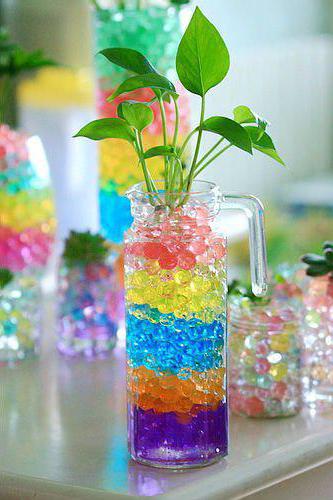

The hydrogel is suitable for flowers with long, well-developed roots. Such plants will not need to be replanted every year. For plants that prefer to grow in a tight container (for example, eucharis), the polymer will not work.
Also, it is not used when growing light-loving flowers. If the plant has leathery, dense leaves, the hydrogel should also not be applied. Excess moisture can negatively affect its development and well-being.
How to make a hydrogel at home
When growing plants in an apartment or in a garden, diapers and diapers fillers are used. This ingredient works in the same way as the hydrogel, improving conditions for plants and prolonging the life of cut flowers.
You will need a nutritious soil and a diaper for this, first you need to cut it and remove the absorbent granules from it. Then they are poured into a container and filled with water. As a result, a gel-like mass is formed, it is mixed with a soil mixture in a 1: 1 ratio, this gel absorbs moisture and gives it away for a long time.
It turns out a loose and nutritious mixture, which, with regular, infrequent watering, will always be wet. Crops growing on such soil will receive as much moisture as they need. The roots will not mold or rot.
A guide to using a hydrogel for growing indoor flowers in this video:
Hydrogel with seed primer
Hydrogel soil is also used for growing seeds. This avoids transplanting plants in the phase of cotyledonous leaves, as happens when using a polymer with water without soil.
Experienced gardeners prefer to mix one part with four parts of soil after preparing the hydrogel. In this case, the hydrogel must also contain water with correctly selected fertilizers.
The mixture is filled into containers. It is recommended to lay a thin layer of crushed pure hydrogel without soil on top. Seeds are introduced into its top layer with a toothpick. They should also not be deeply embedded in the polymer. Next, the container is closed with a film. This is a convenient way to ensure the correct moisture and looseness of the soil for the seedlings.
Using
The hydrogel is used outdoors or when growing indoor plants. Hydrogel is a great help when laying flower beds or lawns, in the course of planting flower beds and trees.
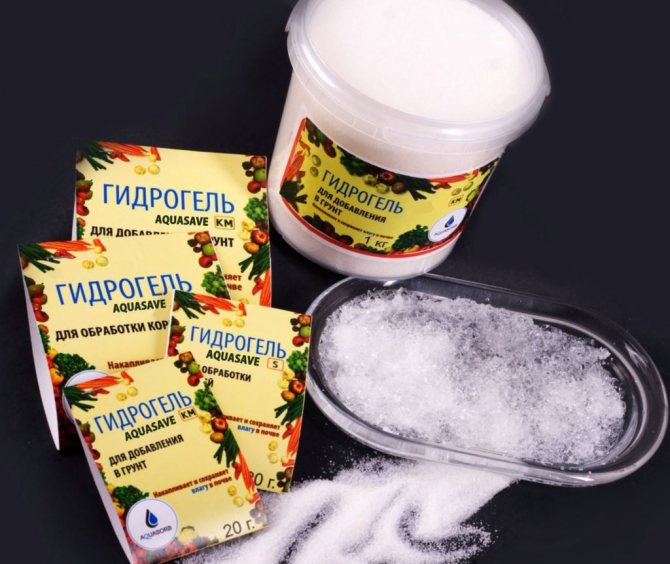

Growing plants in hydrogels and seeds is no less interesting. The granules, after swelling, form a moist environment, which stimulates the emergence of seeds.


Many gardeners are unanimous in the opinion that the gel is an excellent aid for growing any plant, with the exception of those that easily tolerate drought.


Even easier - generalization
If your flower does not wither, this does not mean at all that it is good. If you plant a control plant nearby and create an optimal regime of moisture and nutrition, you will see that it grows and develops better, blooms more abundantly and longer, and looks better. It is this effect, among other things, that the use of a hydrogel gives.
Environmental friendliness and safety
Improving the development of plants occurs in a natural, environmentally friendly way, without the use of any growth stimulants, flowering, etc. Only the conditions of its growth themselves change.
A hydrogel is not a "chemistry" (in conventional terms), since it does not release any substances into the soil solution (it does not dissolve and nothing is washed out from its matrix). Therefore, it has no effect on the chemical composition of plants.
At the end of its validity period, it is completely decomposed by the most common soil microflora. Decomposition products are absolutely safe: ammonium, CO2 and water.
VIEW PRICE>
Caveats
In order for a hydrogel for plants to provide the right conditions for plant development for a long time, a number of nuances must be taken into account. The pot with granules without soil admixture should not be left on the windowsill in direct sunlight. Otherwise, the balls will turn green due to the development of blue-green algae in them. It will also negatively affect the condition of the plant.
Watering the plant in the hydrogel should be done every two weeks. If you accidentally pour too much water into the pot, you can drain it. This will not harm the flower.
Having considered the features of using a hydrogel for various plants, each florist or gardener will be able to provide optimal conditions for the development of their green spaces.
Seed preparation
After the spring processing of the seed of vegetables or flowers, you can not soil your apartment with earth, but use a hydrogel for this. It is necessary to pour 4-5 liters of hot water with dissolved nutrients, 2 tablespoons of polymer granules. In this case, you must be careful: the amount of fertilizer must be reduced by half the usual dose, so as not to damage the delicate roots of the seedlings.
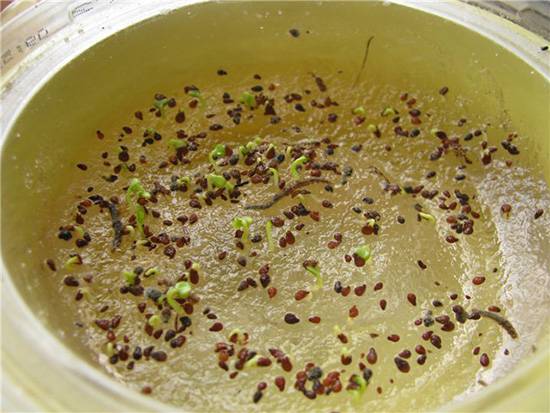

After 2-3 hours have passed, the excess moisture must be drained, and the soaked granules must be placed on a polyethylene film, dried for an hour, and then placed in boxes for seedlings. The seeds are placed on a hydrogel and slightly moistened. The boxes are transferred to the greenhouse, where the young seedlings will be comfortable.
How to grow indoor bamboo: gentle home care
Read about the use of succinic acid for feeding indoor plants in this article.
Breeding methods and proper care for diplopia at home:
Varieties of hydrogel
In addition to color differences, hydrogel is divided into two types - dense and soft.
- Dense, it is called aqua soil. These are balls or pyramids with different shades, they are used as a decorative material for growing flowers. Such material is mainly used for rooting cuttings, plants grow well in aqua soil, but periodically they need fertilizing with mineral fertilizers.
- Soft. Such a hydrogel has no color, and its main purpose is for growing seedlings, introducing them into the soil and germinating seeds. The structure of this product allows the roots of plants to penetrate and receive nutrition and moisture in this way.
But in order for the hydrogel for indoor plants to serve not only for a long time, but also correctly, it must be used according to the instructions.
Analogue materials
In modern floriculture, there are several materials that are similar in their properties to a hydrogel. True, their moisture-absorbing characteristics are somewhat inferior to polymer. However, the substances presented below have several additional functions.
In search of an answer to how to replace a hydrogel for plants, many growers settle on substances such as vermiculi, coconut chips and shavings. They are also able to absorb excess moisture, gradually giving it to the roots of the plant. These are natural materials.
At the same time, vermiculite is able to loosen the earth. This is especially important for plants whose root system needs oxygen to enter it.
When rooting cuttings, one of the best soil fillers is coconut and substrate. They are also able to absorb excess moisture. Coconut chips can be used as a stand-alone substrate for orchids and similar plants.
Germinating seeds on a hydrogel
The method is often used by flower growers, sprouting flower seeds. The method is effective for germinating seeds of cereals (sprouts), which are especially popular among adherents of proper nutrition.
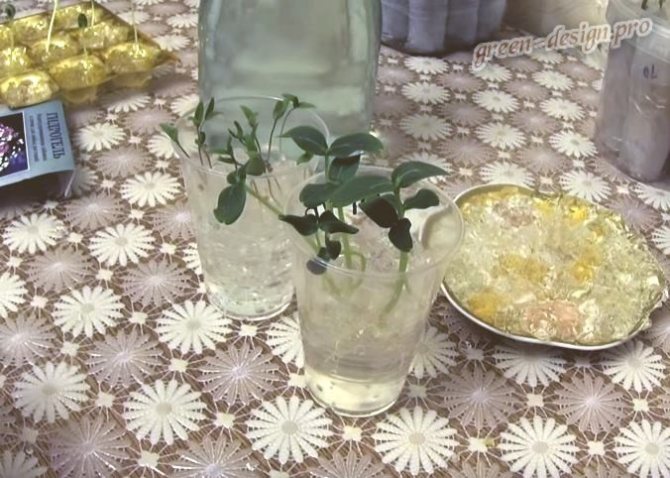

The use of a hydrogel when growing seedlings from seeds
To organize sowing, you will need to pre-soak the granules, and after they are completely saturated with water, grind them by rubbing them through a sieve or using a blender. A fine crystalline mass resembling jelly will cure. It is laid out in a small container, with a layer of about two centimeters. Seeds are laid out on crushed crystals, slightly deepened. The landing is covered with a film. After the first shoots appear, the film is removed, allowing the shoots to grow. The grown sprouts are transplanted into the ground, and in the case of sprouts, they are left to grow on improvised crystals.
Properties
The hydrogel colored and colorless granules for the substrate have different applications. Their properties are also different. Ornamental varieties are used as a separate material for different types of plants. It is placed in vases of flowers. When added with water, the hydrogel can serve as an air freshener.
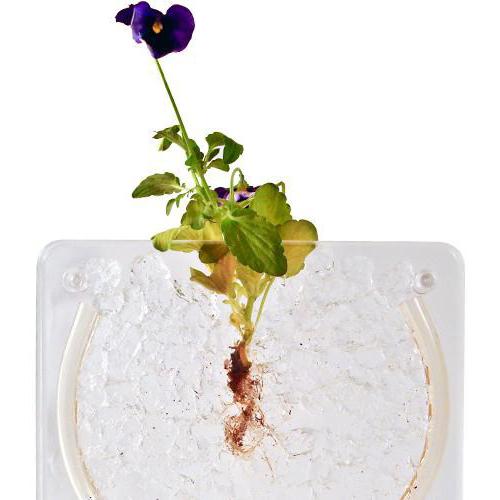

A transparent hydrogel has no decorative qualities. It can be mixed with soil. If you add fertilizer to the water for irrigation, the granules will absorb this mixture and begin to perform a double function. Plants will receive not only moisture, but also the components necessary for their development.
Polymer granules on the market today are notable for their low cost. According to the manufacturers, such material is completely safe for human health and the environment. It is an environmentally friendly polymer. After 2-3 years of his service, he loses his aesthetic qualities. At the same time, it will absorb moisture as well as before. The balls can be taken outside and buried in the garden. The material does not require special disposal.
Hydrogel benefits
- The granules are absolutely safe, non-toxic. At the same time, the use of hydrogel instead of soil helps to prevent the appearance of midges that breed in the soil. Hydrogel for plants is an absolutely sterile environment in which bacteria, insect larvae and other microorganisms cannot live. When the substance is used together with the soil, after its expiration date, the granules simply decompose into carbon dioxide, water and ammonium. These substances are part of the soil. With this combined use, the balls will last about 5 years.
- Hydrogel granules have a decorative and aesthetic appearance. Placing the granules in a transparent pot, an amazing composition will flaunt on the windowsill. At the same time, the flowers in the hydrogel grow very well.
- For normal soil moisture, a flower hydrogel is a very useful invention. By soaking it with water and mixing it with the soil, you can avoid drying out or waterlogging of the soil. Then the plant will receive moisture as needed. And if you saturate the balls with liquid fertilizers and spread them on the bottom of the pot, then the need for fertilizing will disappear, since the plant will receive fertilizers dosed, for a long period.
- Using this development will significantly save time on watering plants. Watering the hydrogel for indoor plants, mixed with soil, the granules will be saturated with moisture and gradually release it. In this case, the need for daily watering disappears, and you can water the plants once a week or two.
- Saving money on fertilizers. When using liquid fertilizers, most of them drain into the pan, and when using hydrogel granules, all fertilizers are absorbed into them and are evenly consumed.
The advantages of this tool are obvious, so it is worth using this material. Even after it has lost its aesthetic appearance, you should not throw it away. The decomposition time of the granules is five years. Therefore, the pellets can simply be buried in plant pots or garden beds.
Planting seedlings
Another convenient way to use a hydrogel. In this way, it is convenient to transplant seedlings of shrubs and trees.
A few handfuls of hydrogel swollen in water are placed in a hole dug under the seedling. Be sure to thoroughly mix the gel with the ground, and put a seedling on this ready-made mixture. It remains only then to level the hole with the seedling with earth.
If crystals are placed in the soil where the plant was planted and mixed with the soil, the granules will accumulate moisture, and in a dry period they will give it back. And if the soil is too waterlogged, then they will take excess water on themselves.
Product Description
Few know what a hydrogel is, despite the fact that it is gaining more and more popularity. Gel beads are a common polymer that has been crushed into powders or granules of various shapes.
The peculiarity of hydroballs is their ability to absorb significant volumes of liquid, which later simply evaporates or is absorbed by the rhizome of the plant. Thanks to this ability, even the smallest balls can swell to very large sizes.
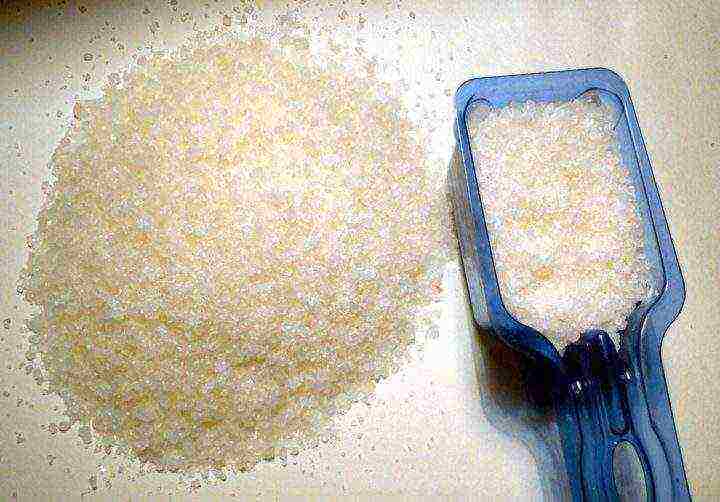

Hydrogel in crystals
1 g of hydrogel granules can absorb about 200 ml of water. Therefore, to remove about 3 liters of liquid, you only need 2 tbsp. l. balls.
A hydrogel is a sterile substance. In it, pathogenic microflora is unable to start.The material gives off moisture gradually and slowly, so you don't have to worry about the possible rotting of the plant rhizomes.
The balls do not contain any useful ingredients.
Growing indoor plants in a hydrogel - the latest technology
The hydrogel will also help plants growing on the windowsill. If you are planting in a new pot, the presoaked polymer is added to the potting mix. Moisten it well (1 g per liter of soil) and let it absorb water. You can soak it overnight.
During planting, mix the prepared granules with the soil mixture, then plant the plant according to the general rules. After planting the seedling, water it, the roots have not yet adapted to the new place, but they need nutrients. You can only feed with water-soluble compounds and not as often as plants in ordinary soil.


If you need to add polymer to a pot with a growing indoor plant, then you must first calculate its volume. For 1 liter, you need to add 1 g of dry granules, this is about ¼ teaspoon. Puncture the soil down to the bottom of the pot and add the hydrogel to it.
Then the plant needs to be watered, if some granules appear on the surface - they need to be sprinkled with soil 1-2 cm thick, after a short time the roots will reach these granules. And the lack of moisture for 15-20 days will not harm them, so if you go on vacation, you will not have to worry about your pets.
For which plants is it suitable?
Hydrogel is used in the cultivation of many types of plants. However, for some of them, the polymer is not suitable. This primarily applies to succulents. Such plants themselves are capable of accumulating moisture. Therefore, they simply do not need additional moisture-containing components.
The most commonly used hydrogel for orchids. In this case, even aqua soil consisting of colored balls is suitable. A flower of indescribable beauty will look even more spectacular in a transparent pot with a similar filler.


For most flowering, deciduous ornamental plants, the hydrogel can be freely applied to the hydrogel. He is able to give the necessary consistency to the soil. Clay soil will become looser, and sandy soil, on the contrary, will be less crumbly.
Variety of hydro balls
The gel beads are available in two of the most common forms - soft and firm. They differ in structure, purpose of application, and cost.
Soft gel beads are the most common type. It is introduced into soil mixtures for indoor flowers, for germinating seeds, for planting horticultural and horticultural crops. Due to the elastic and soft structure and small size, the roots of the plant can freely and freely penetrate directly into the balls and through them and absorb moisture and nutrients.
Such a hydrogel is always made colorless and, in rare cases, is operated independently. Most often, hydroballs are mixed with a substrate, this helps to prevent soil acidification from introducing a large amount of liquid and contributes to its speedy and uniform drying.
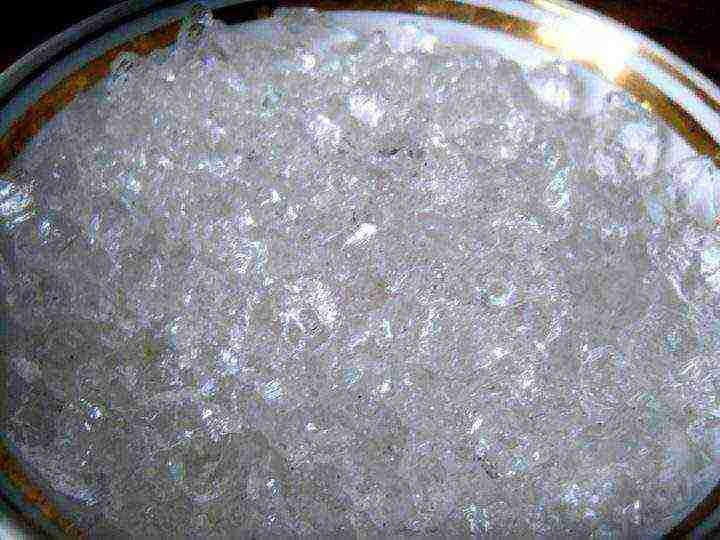

Hydrogel
Dense gel balls (or aqua soil) are much more expensive than soft ones. The material can be of different shapes and sizes. The high price does not allow the use of such material in horticulture and horticulture. The aqua primer differs from the usual gel and in that it can include rhinestones, sparkles, and is often painted in different colors. Such a colored hydrogel is used for transparent flower pots, in addition, it can be used to create charming florariums.
Another use for hard gel beads is air freshening. To improve the smell in the room, dry gel beads are poured with water with essential oils or other scented liquids.When the aqua soil is saturated with moisture, the balls are laid out in glass containers and placed around the room. A pleasant aroma will spread throughout the apartment for a long time.
Such soil is very convenient: even if a family member or a pet overturned a container with balls, they can be very easily collected even without using a vacuum cleaner.
It is important to remember that when filling with colored balls, you need to decompose each shade in different containers and let them swell in water. Only then can they be mixed.
Putting the gel into the ground
1. When landing. During the preparation of the soil for future flower beds and beds, the gel is applied dry, and then watering is carried out. On 1m2 of surface, 25-100 grams of dry mix is used. The soil is properly dug up, the dry gel is applied and everything is mixed. The soil after planting the plant is watered abundantly.




2. For plants. In the middle of the projection of the bush, a depth of about 20 cm is performed with a pitchfork. The gel is poured onto the bottom of the formed holes, after which the plant is watered. Watering should be repeated after about an hour.
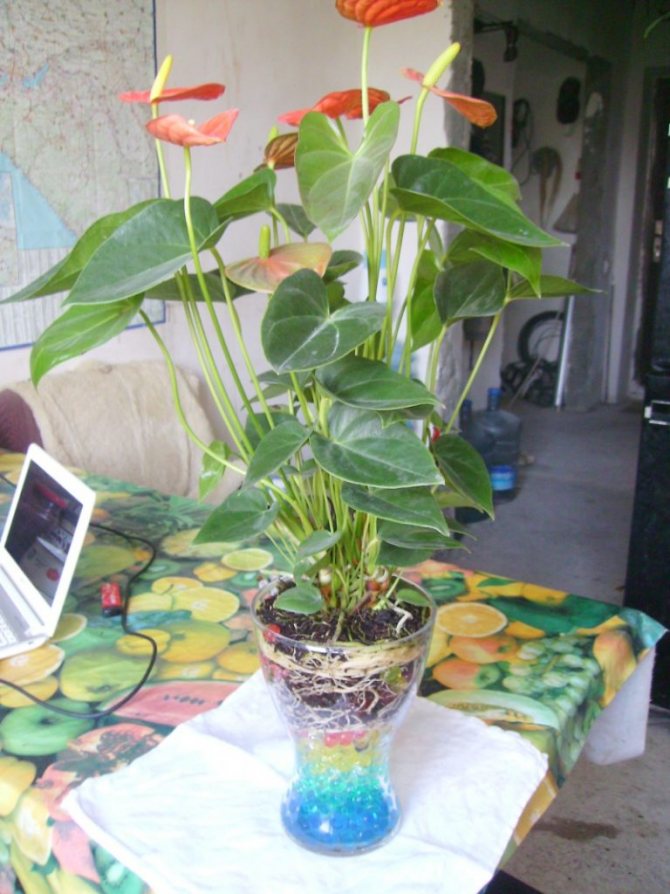

Advantages and disadvantages


The positive qualities of a hydrogel for plants include:
There are few disadvantages of the substance:
- the composition of the hydrogel is not suitable for the germination of legumes and sweet peas;
- prolonged exposure to the sun can lead to mold;
- if used in pure form, it should be changed every two years.
To make sure of the effectiveness of the granules, it is worth applying it on your own site or on home plants.

